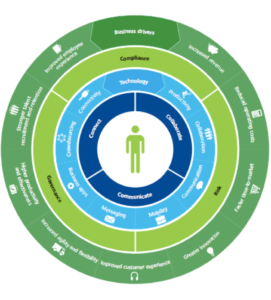4 steps to defining your digital workplace strategy
Today’s workplace belongs to the off-site and remote employees who create and work outside the confines of a physical office. To reflect this change in staff needs, businesses are evolving to a digital workplace. Where does this journey begin? A comprehensive digital workplace strategy is a good start.
The old idea of the workplace being somewhere employees spend physical time is no more. Because of this, the notion of the digital workplace has risen in popularity.
The digital world is bursting with content, information, and tools that make collaboration and management a tricky task. Combining communications, ideas, and systems in a way that keeps order and acts as a hub for effective information sharing is what makes your digital workplace.
Most businesses know that to stay abreast of the competition, evolving to a digital workplace is the way to go. However, the digital workplace is not something that many organizations have begun to craft. According to Dimension Data’s Digital Workplace Report, only 17% percent of enterprises have plans to devise a formal digital workspace strategy in the next two years. This is a number that will undoubtedly change in the coming years as organizations reformat and progress.
Building a connected digital workplace
Digital Workplace: Why make the transition?
Believe it or not, you are closer to a fully-functional digital workplace than you may think. In fact, we already exist and operate digitally.
From staff responding to e-mails on their phones to interacting with VR and bots, our workplaces are already undergoing the changes necessary to help us work smarter and faster.
However, these budding digital tools and experiences – while innovative – remain fragmented and often fail to work seamlessly alongside one another. Delivering the user experience expected by employees means that organizations must recognize the potential of the digital workplace.

Deloitte’s report, “The digital workplace: Think, share, do” shares a compilation of benefits gained by adopting a digital workplace:
- Talent attraction: 64% of employees would opt for a lower paying job if they could work away from the office.
- Employee productivity: organizations with strong online social networks are 7% more productive than those without.
- Employee satisfaction: organizations that installed social media tools internally found a median 20% increase in employee satisfaction.
- Employee retention: when employee engagement increases, there is a corresponding increase in employee retention by up to 87%.
- Communication tools: information workers prefer newer communication tools, particularly instant messaging, over more static forms such as email.
The facts are clear: these employees are calling for the advantages provided by a digital workplace. Yet, many still hesitate to take the plunge.
The fear of overwhelming costs may make you falter. Other reservations include compliance issues (56%), employee resistance to change (54%), getting buy-in from other parts of the company (53%), lack of a clear and measurable return on investment (53%), and lack of thought leadership (51%). (Dimension Data)
But, even knowing all this, the risks of inaction are reason enough to invest in your digital workplace solutions. To keep pace with the market and recent trends, enterprises cannot afford to be stagnant in the face of this evolution.
Building a connected digital workplace
Why you need a digital workplace strategy
While you most likely won’t be building your digital workplace from scratch, adopting a clear roadmap in the form of a well-planned digital workplace strategy can help you along the way.
There is no definite action for developing a digital workplace, and information available on the subject is regarded as more of a hindrance than helpful. For these reasons, attempts at beginning the implementation process often do not succeed or never even take off to begin with.
Don’t lose the war before you even start the battle. The key to any successful maneuver is to go in prepared. Much like defining your comms strategy, your digital workplace strategy is made up of a number of fine-tuned components.
Our digital workplace guide addresses the three key elements in any digital workplace framework:
People: Our employees, their digital needs and the impact that has on key indicators such as engagement, productivity, and innovation – but also the resulting impact on our customers/consumers, suppliers, and stakeholders.
Tools: The technologies and applications that make up the ‘digital’ element of how we communicate, collaborate and work day-to-day.
Culture: When these two elements — people, and tools — come together in a strategic and considered way, they collectively shape the employee experience. Aligning this with our business mission, values and overall direction becomes the foundation of our corporate culture and drives employee engagement.
Success requires a holistic approach: a digital workplace design that considers the people it serves, the tools they use, and how everything comes together to deliver a positive experience for our employees.
Enterprises need a digital workplace strategy yet, only 39% of enterprises say they already have a defined and agreed-on digital workspace strategy encompassing the elements above. A further 40% have elements of a strategy, such as a strategy encompassing communications and collaboration tools or mobility and end-user computing, but not all components.
These components are a head start to a holistic, employee facing workplace. You already have the ingredients in place.
What does a digital workplace strategy need to answer?
When it comes to building out your digital workplace strategy, there are a few questions that need answering, such as:
- What tools do your employees need, want and use?
- Do these tools support your business objectives?
- How do they work together concerning integration, authentication and the user journey?
- Which tool is right for the job – are employees aware of what to use and when?
- How easy it is for our employees to get things done in our digital workplace?
- Is the user experience offered simple, intuitive and employee-focused?
Answering these can help develop a comprehensive approach that views the entire digital ecosystem. While there may be no set standard for creating your digital workplace strategy, here a few critical steps you may not want to skip.
1. Define the why
Before embarking on any journey, the leader and those who follow them must understand its significance. As such, at the center of any digital workspace strategy should lie an outlined vision for what the digital workspace will look like and its future functions.
You must identify key goals. Are you looking for more engagement? Better productivity? Enhanced collaboration? Asking yourself the questions above can help you form a foundation for mission and objectives.
Figure out which components are crucial to not only your business but to your employees. Keep them in mind when developing your strategy, They will help the team stay aligned with the big picture throughout the process.
While the vision often begins with what you think the organization needs, it is important to involve the ideas of the stakeholders in the early stages. Open up the discussion and allow those you work closely with (HR, IT, managers, etc.) to share. Learn what they want and expect from a digital workplace.
This feedback will get you an all-encompassing view of what is necessary to achieve the collective vision. Once you have a starting point, consider drafting a mission statement or a roadmap. With this, you can ensure you are addressing the three core elements in your digital workplace strategy: people, tools, and culture.
Don’t let the current or future budget or costs constrain you. A successful strategy leaves room for adjustments and expansions in either direction. Focus on the steps necessary to fulfill your desired outcome.
2. Identify the state of your workplace
Now that you know where you want your strategy to go, it’s time to figure out exactly where you are. No two organizations are at the exact same point. Every company is riddled with its own share of challenges and trials.
Because of this, you cannot blindly apply the same plans and solutions as others and expect a positive result. Your process is your own and formulating a winning plan starts with understanding where you are in the process of digital transformation.
Check your workflows. Assess your tools, processes, and services. Have you discovered any that bring more harm than good? Get everyone involved one more time and take a survey to find out what works, what doesn’t and what needs adjusting.
This is your chance to plan out and obtain the tools necessary to reach your goals while removing anything that brings your team farther away from the endgame.
Don’t get too ambitious and bite off more than you can chew. Analyze your findings while taking a look at how the market is approaching their digital transformations. Getting an accurate glimpse into your own business environment is the first step to getting ahead of your completion. This step is essential to dictate and direct your actions moving forward.
Building a connected digital workplace
3. Create your digital workplace team
You’ve defined your goal, found the necessary improvements, and are now well on your way to carrying out the perfect digital workplace strategy. The outline you’ve created has everything you hope to develop and the steps needed to get there. But what are you missing?
The digital workplace is all about the employee experience. What better way to ensure that your staff and vital members are satisfied with your mission than to include them in the process? This is a company-wide initiative and as such, the people with expertise in the areas of people, technology and culture need to be a part of your team from the start.
You’ll need your IT leaders. They are the people who have both the knowledge to suggest the right technical tools, as well as the skill to deploy any necessary technical solutions. Problems are bound to occur, and when they do, you’ll want IT on your side.

Then you have your management. These individuals have the sole task of keeping everyone connected. While seemingly simple, there is a lot of weight resting on their shoulders. While you are busy planning your next moves, they will make sure your initiatives get approved and that everything stays on track.
The last member of your dream team is HR. They are the ones that manage the core of any workplace – employees. Any organizational change can be a stressor for employees, and this is no different. Your HR department is here to back you up behind the scenes. Their goal should be to understand employee needs, monitor the effects of the transformation while also maintain high rates of motivation and engagement…easy.
4. Analyze and measure
Your team is assembled, and the process of digital transformation has begun. But your job is not over. Even as you start to define, develop and eventually utilize your digital workplace, a crucial part of strategy means keeping an eye on the metrics.
Measure your way to success and view the fruits of your investment. Consistency and clarity are crucial. For your digital workplace strategy, define clear metrics that match your established vision, are frequently measured and are shared with your stakeholders.

Metrics are necessary to keep a transparent and accurate idea of your digital workplace’s performance levels. These can be in the form of KPIs to follow, and outline of regular actions to take and maintain, as well as defined actions for when specific initiatives are not performing well. Additionally, tracing metrics can detect a problem before it becomes a larger issue. Staying ahead of the curve is the only way to drive a successful business strategy.
Tracking and communicating these points to your team and stakeholders can bring your employees even closer to your mission. They increase their commitment and in turn, their long-term engagement.
Implementing company-wide solutions
Digital transformation can come about in any number of ways, but the overarching goal remains the same regardless of industry or location. Leaders just want their employees to be able to work together more efficiently. They want to boost productivity. They want better customer service from high-morale employees. They want to find new ways to incorporate time-saving technologies. And most of all, they want to embrace the oncoming transformation into the future of the workplace.

